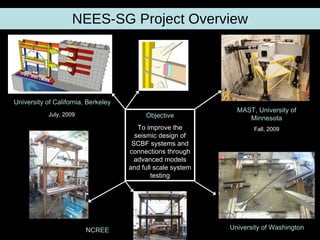2009 NEES Presentation
- 1. Experimental Performance of Three Story SCBF Systems Eric J. Lumpkin Graduate Student – University of Washington Charles W. Roeder Professor – Principal Investigator (PI) University of Washington Dawn E. Lehman Assistant Professor – Co-PI University of Washington 2009 NEES Conference June 25, 2009 Po-Chien Hsiao Graduate Student University of Washington K.C. Tsai International Collaborator Professor, Director of NCREE
- 2. NEES-SG Project Overview Objective To improve the seismic design of SCBF systems and connections through advanced models and full scale system testing University of California, Berkeley July, 2009 NCREE University of Washington MAST, University of Minnesota Fall, 2009
- 3. NEES-SG Project Overview University of Washington Develop improved design methods for SCBF’s Establish a performance based design technique Identifying and classifying yield and failure mechanisms Brace Buckling Brace Yielding Gusset Plate Yielding Column/Beam Yielding Brace Fracture In design, how do we ensure this yielding hierarchy occurs? Balanced design procedure ( β ) Ensures ductility instead of resistance Validated through 28, single bay, single story tests at UW
- 4. NCREE Test Setup More accurate boundary conditions than UW test setup Tested vertically Additional demands from concrete slab Fully restrained column bases Reused frame between tests Simply removed and replaced gusset plates and braces Allowed for rapid testing Loaded applied to frame through top story slab Use of blue out-of-plane frame
- 5. Two Story Testing at NCREE (TCBF 1) Tomorrows Concentrically Braced Frame 1 (TCBF 1) Two story, X-Brace configuration 8t elliptical clearance on corner and middle gussets 8t 8t Edge Stiffeners
- 6. Extension to Three Story Testing Investigation of unique gusset plate configurations Chevron configuration Gussets on either side of a beam Modification of middle gusset plate clearances Eliminate middle gusset edge stiffeners 8t 6t
- 7. TCBF 2 TCBF 2-1 (HSS) TCBF 2-2 (WF) TCBF 2-3 (2t, IP) Construction Drawings Completed Specimen
- 8. TCBF 2-1 (HSS) Performance Frame Drift: -1.74% to 2.08% 1 st Story: -2.20% to 2.18% 2 nd Story: -2.15% to 2.17% 3 rd Story: -1.06% to 1.07%
- 9. TCBF 2 Test Series Performance TCBF 2-2 (WF) Frame Drift: -2.43% to 2.43% Frame Drift: -1.74% to 1.74% TCBF 2-3 (IP) Drift Ranges 3.48% 4.86% 3.82% Frame 3 rd Story 2 nd Story 1 st Story 2.13% 4.32% 4.38% TCBF 2-1 (8t,HSS) 1.99% 4.61% 3.99% TCBF 2-3 (2t, IP) 2.99% 5.74% 5.21% TCBF 2-2 (8t, WF)
- 10. TCBF 2-2 (WF) 1 st Story Video
- 11. Brace Buckling and Yielding TCBF 2-1 (HSS) TCBF 2-2 (WF) N S N S
- 12. TCBF 2-1 Middle vs. Corner Gusset Plate Middle Gussets Corner Gussets N S N S
- 13. TCBF 2-2 Middle vs. Corner Gusset Plate 3.05% SD Middle Gussets Corner Gussets N S N S
- 14. Brace Fracture TCBF 2-1 (8t, HSS) TCBF 2-2 (8t, WF) N S N S
- 15. TCBF 2-3 Connection In-plane buckling detail Achieved via rotation of a “knife plate” Gusset plate to remain elastic Majority of inelastic action in knife plate 20 mm knife plate 18 mm gusset plate 2t hinge region on knife plate 2t
- 16. TCBF2-3 In-Plane Buckling Video
- 17. TCBF 2-3 Brace In-Plane Buckling 1.06% SD 1.86% SD 2.32% SD N S
- 18. TCBF 2-3 Knife Plate Yielding and Rotation N S N S
- 19. Preliminary Conclusions TCBF2-1 (HSS) and TCBF 2-2 (WF) The type of brace has a large effect on system performance WF braces more ductile than HSS braces however loose strength rapidly post buckling WF braces place a greater demand on the connections than HSS braces Elliptical clearance only valid for corner gusset plates 6t horizontal offset allows for significant inelastic action while limiting the occurrence of buckling TCBF 2-3 (In-Plane) In-plane buckling SCBF’s similar to the performance of OOP buckling SCBF’s Knife plate connection allows for greater connection rotation Increased serviceability
- 20. Acknowledgements K.C. Tsai and NCREE Staff Chih-Yu Wei, An-Chien Wu, Ching-Yi Tsai My advisors – Dr. Charles Roeder and Dr. Dawn Lehman Po-Chien Hsiao NEES and NSF Our advisory committee




















